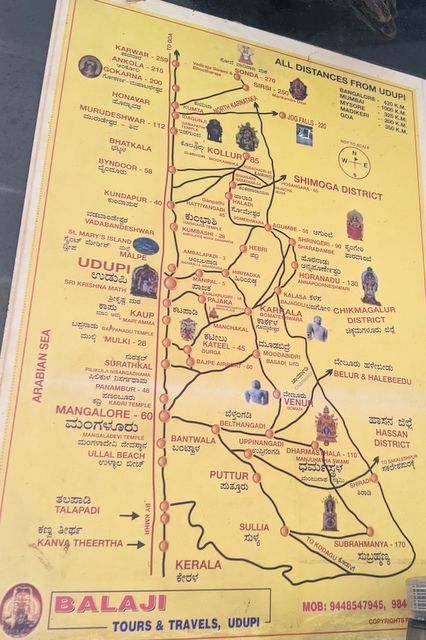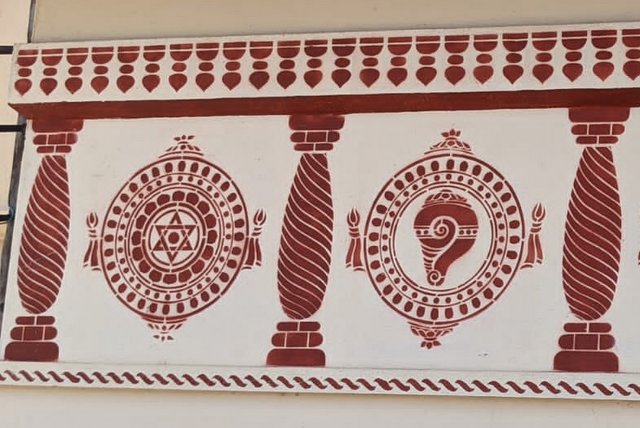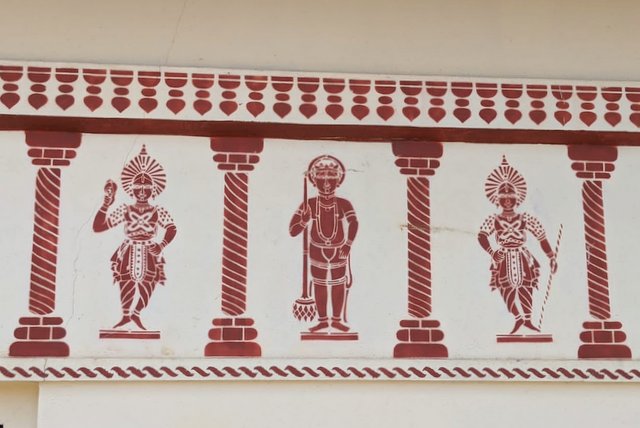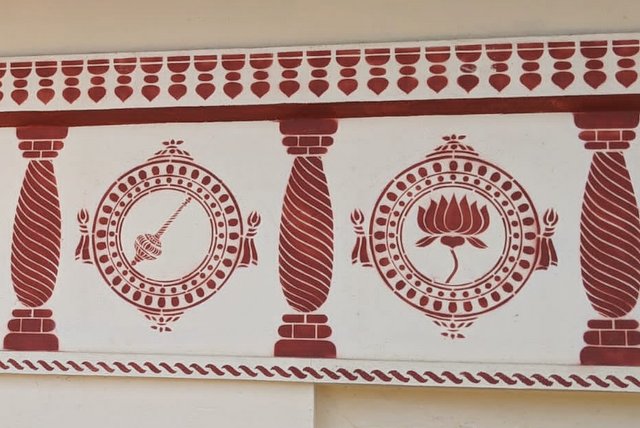Situated in Coastal Karnataka, Udupi is popularly known for its temples and tempting cuisine. At the heart of the town lies the Sri Krishna Mutt. Established by Shri Madhavacharya in the 13th century, the temple is surrounded by 8 Mutts and is visited throughout the year by pilgrims. On the premises of the same temple are two other ancient Shiva temples of Udupi that often go unnoticed.
They are the twin Shaivite temples called Anantheshwara and Chandramoulishwara. The presence of these temples made Udupi a holy land even before the establishment of the Shri Krishna Mutt. It is customary to visit them before proceeding toward the Shri Krishna temple.
Shiva Temples of Udupi
The Chandramoulishwara Temple
The history of the temples is intertwined with the name Udupi. The name “Udupi” is derived from the Sanskrit term “Udupa”. This literally translates to the “Lord of the stars”, the Moon. According to the popular legend, the moon was married to 27 daughters (signifying the 27 constellations) of Daksh Prajapati. While the moon enjoyed the company of Rohini, he ended up ignoring the other 26 wives. On complaining to their father, Daksh Prajapati cursed the moon that his radiance will diminish and will be lost in total oblivion. To atone for this curse, the moon started performing penance and austerities to Shiva Mahadev.
Shiva was pleased and granted the moon the ability to wax and wane instead of completely diminishing. The land where the moon is said to have performed penance was known as Abjaranya which is now Udupi and the nearby lake turned into the Chandrapushkarni. Hence, Shiva is given the title of Chandramoulishwara.
The temple complex
The present Chandramoulishwara temple dates back to the 8th century CE. The temple is built in traditional Udupi-style temple architecture. It has a sloping roof and cooling granite stone to walk on. This temple is right opposite the Shri Krishna Mutt and shares a wall with the popular eatery Mitra Samaj.

The Nandi here is tilted and one has to tilt their head in a similar way to see the Shiva ling. This temple is at a lower level about 6 feet below ground level and one has to climb down a few steps to enter the temple. Despite this height difference, this temple has never been flooded.
It is believed that this Sphathik (quartz) Lingam changes color thrice during the day; black in the morning, blue at noon, and white at night. This lingam is covered by a Mukha (face mask). Even to this day, the Paryaya Swamiji visits Chandramouleeshwara temple before ascending the Paryaya throne and then proceeds to receive the darshan of Lord Anantheshwara and Sri Krishna.
The Anantheshwara Temple
The Tullu word for Udupi is Odipu. This comes from the Sanskrit term “Rajatapithapura” which means, “The city of the silver pedestal”. The name comes from the ancient silver pedestal that enshrines the Ananteshwara lingam. King Ramabhoja who ruled over this Parasurama-Kshetra decided to perform Ashwamedha yajna – a ceremony performed to declare the present King as the greatest of the land.

The yajna Bhoomi was on the western side of the Chandramoulishwara temple. While ploughing the land for the yajna, a snake got caught in the ploughshare and was instantly killed. The King prayed day and night to atone for the sin of Sarpahatya or killing a snake. Shiva Mahadev was pleased with his penance and told him to build a silver pedestal and a lingam on the yajna Bhoomi.
This temple is now known as the Ananteshwara temple. Being the oldest temple of Tullunadu, this shrine is the spiritual center for the Shivalli Brahmin community. It is also said that Madhavacharya’s parents prayed to the deity in the Ananteshwara temple for 12 years for the birth of a child.
The temple complex
The Ananteshwara temple dates back to the 2nd century CE. It is built by joining granite slabs with limestone plaster. The temple is rather unique for its deity, Shiva is accompanied by Sheshnaag. Hence, it is worshipped by both Vaishnavites and Shaivites.

There are 2 parts to the Garbhagriha or Sanctum Sanctorum. One is visible to the devotees and the other is hidden behind the Moolasthana or the Altar. One can also observe Shankha and Chakra markings on the entry gate. The 40 feet high Deepasthamba outside the temple is a unique landmark. Devotees light this lamp with oil as an offering.

On circumambulating the temple, one can see the deities of Ganapathi and Parvathi. At one corner of the temple are two small but powerful deities of Sheshnaag and Aiyappa Swami. The Sheshnag is made of gold.

Mahashivaratri Celebrations at Shiva temples of Udupi
A special Rudrabhishekam and Bhilvapatra Archana (The most auspicious way of worshipping Lord Shiva is by performing a ceremony with Bilva leaves) is conducted in both temples. The Madhava’s (the brahmin community which follows the teachings of Madhavacharya and worships Vishnu) instead of fasting on Shivaratri, have a sumptuous feast. They do not have any inhibitions in worshiping Shiva. They meditate upon the Sivapanchakshara mantra and offer upcharas (offerings and services made to a deity as part of worship) while performing various pujas.
A Rathotsava is held every night during the festive period for both temples. On the last day of Mahashivaratri, a special Rathotsava takes place for Ananteshwara. I visited the temple the day after Shivaratri and it was serene. There was hardly anyone present in the temple and I felt the positive vibration surround me.
In Mathura too we see there are four ancient Shiva temples guarding the city of Krishna, that are believed to be older than the time of Krishna, just like the Shiva Temples of Udupi.
Culture and Cuisine
Udupi is the melting pot of three different cultures, the Kannadigas, the Tuluvas, and the Konkanis. It is an integral part of Tulunadu and the ancient Parshurama kshetra. As a result, the cuisine is a beautiful culmination of spices and flavors from all three cultures.

Sajjige Bajil, Mangalore Buns, Goli Bhaje, Biscuit Ambade, Bonda soup, sweet Avalakki, Sanna Polla, and Menthe dose are found in many eateries around the temple complex. You can specifically find them in the 100-year-old Mitra Samaj. Eating crispy masala dose, Moode idli, and finishing up the meal with a hot glass of filter coffee will satisfy your soul.
Read More – The Best Street Food of India
For lunch, an authentic plate of vegetarian Konkani food is served in many restaurants consisting of different kinds of Upkaris, Dali Toye, and Podis. In Basaveshwara Khanavalli you can fill your hunger pangs with delicious North Karnataka meals. Some of the dishes served here are Jolada roti, Enggai Palya, and Holige.
Udupi is also famous for icecreams. The well-known “Gudbud” ice cream was invented in Hotel Diana. Every restaurant here serves a variety of ice cream sundaes made from the popular Ideal ice creams. They tend to be refreshing in the heat and humidity. Since Udupi has been catering to pilgrims for centuries, there are restaurants that serve quality North Indian food as well.

Best time to visit Shiva temples of Udupi
The months from September to February are the best time to visit Udupi. During the summer, the heat and humidity can be very revolting. June to September experience heavy rainfall. Although the rains can turn into a travel hindrance, the monsoon brings out the lush greenery in and around Udupi. Since Monday is an important day for Shiva, the temples tend to be a bit crowded.

Transportation and accommodation
The nearest airport is in Mangalore and is located at a distance of 55 km from Udupi. You can fly to Mangalore and hire a cab to Udupi.
If you enjoy train journeys, I would recommend traveling on the Karwar express as well as the Vistadome from Bangalore. This train journey of 8 hours will provide you with breathtaking views of the western ghats. Bus services from Bangalore, Mumbai, Pune, and Mangalore are also available.

Since Udupi has been a center of pilgrimage for many years, there is no shortage of accommodation. Based on your price range, you can find guesthouses, Dharamshalas, hotels, and homestays. You will find a variety of scrumptious vegetarian food.
This post is authored by Akshaya Vijay as part of the IndiTales Internship Program.
